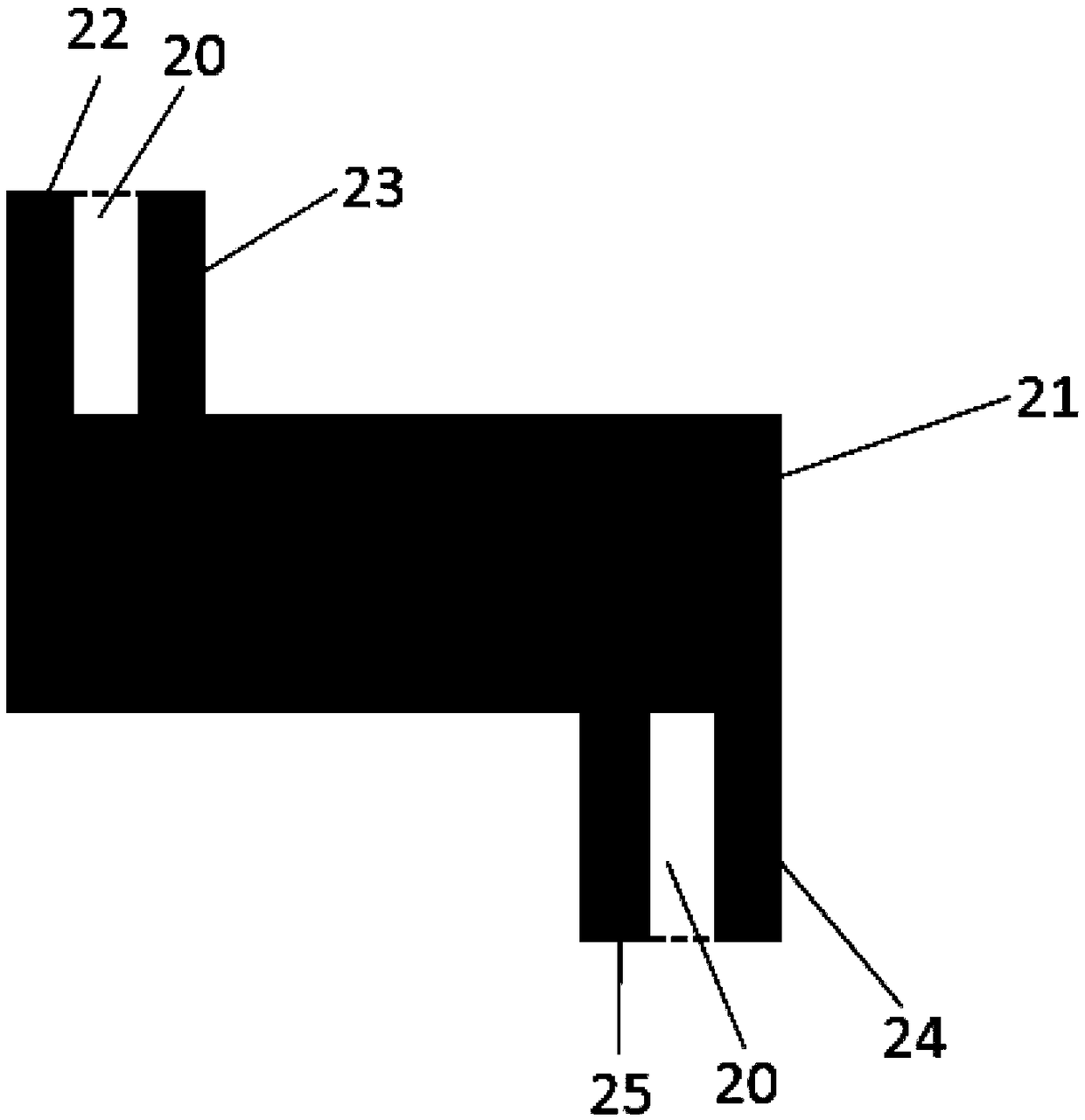Double-F-shaped nanopore array and method therefore for regulating and controlling circular dichroism
A nanopore array, nanopore technology, applied in nonlinear optics, instruments, optics, etc., can solve the problems of difficult to control the size and position of the signal, weak circular dichroism signal, etc., and achieve a simple, fast and easy adjustment method. , the effect of easy preparation
- Summary
- Abstract
- Description
- Claims
- Application Information
AI Technical Summary
Problems solved by technology
Method used
Image
Examples
Embodiment 1
[0032] A double F-type nanohole array, which is composed of a plurality of metal nano-unit structures spliced in a rectangular periodic array, each metal nano-unit structure is made of a rectangular metal nano-film 1, and the middle of the rectangular metal nano-film 1 forms a center Symmetrical double F-shaped nanopores 2 . The double F-type nanopore 2 is composed of a first rectangular hole 21 , a second rectangular hole 22 , a third rectangular hole 23 , a fourth rectangular hole 24 and a fifth rectangular hole 25 .
[0033] in particular:
[0034] When incident light irradiates the structure of this embodiment, the structure of this embodiment belongs to a planar chiral structure, which has different absorption rates for left-handed and right-handed circularly polarized light, thereby generating circular dichroism.
[0035] Such as figure 1 and figure 2 As shown, the long side of the first rectangular hole 21 is parallel to one side of the rectangular cycle, and is a...
Embodiment 2
[0042] In order to further illustrate the circular dichroism effect of the double F-type nanohole array in the embodiment of the present application, this embodiment discloses the size and the principle of the circular dichroism of the double F-type nanohole array in embodiment 1. Using the three-dimensional finite element simulation software COMSOL Multiphysics, the characteristics of the double F-type nanohole array were numerically simulated, and the specific parameters were optimized as follows:
[0043] The side length of the rectangular period is P x=600nm,P y = 600nm. The thickness of described rectangular metal nano film 1 is 40nm, the length L=480nm of described first rectangular hole 21, width W=200nm, described second rectangular hole 22 and the 3rd rectangular hole 23 and described 4th rectangular hole 24 and the fifth rectangular hole 25 have a length l=160nm and a width w=50nm, and the width of the gap 20 is g=50nm.
[0044] The rectangular metal nano film 1 i...
Embodiment 3
[0049] This embodiment discloses a method for regulating circular dichroism. The method for regulating circular dichroism in this embodiment is based on the double F-type nanohole array proposed in the above-mentioned embodiment 2. In this embodiment, by changing the double F-type The structural parameters in the nanohole array can be used to change the symmetry of the structural unit and realize the regulation of the size and position of the circular dichroism. Using the 3D finite element simulation software COMSOL Multiphysics, the characteristics of the double F-shaped nanohole arrays were numerically simulated.
[0050] The first is to regulate the circular dichroism signal through the distance between two rectangular holes, and the specific parameters are preferably as follows:
[0051] The rectangular period is preferably a square period P x =P y =600nm, the thickness of the rectangular metal nano film 1 is 40nm. The length of the first rectangular hole 21 is L=480nm,...
PUM
| Property | Measurement | Unit |
|---|---|---|
| length | aaaaa | aaaaa |
| length | aaaaa | aaaaa |
| width | aaaaa | aaaaa |
Abstract
Description
Claims
Application Information
 Login to View More
Login to View More - R&D
- Intellectual Property
- Life Sciences
- Materials
- Tech Scout
- Unparalleled Data Quality
- Higher Quality Content
- 60% Fewer Hallucinations
Browse by: Latest US Patents, China's latest patents, Technical Efficacy Thesaurus, Application Domain, Technology Topic, Popular Technical Reports.
© 2025 PatSnap. All rights reserved.Legal|Privacy policy|Modern Slavery Act Transparency Statement|Sitemap|About US| Contact US: help@patsnap.com



